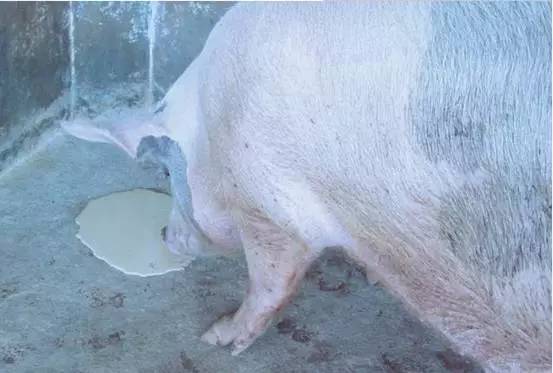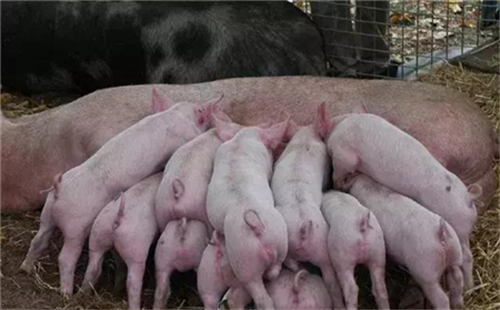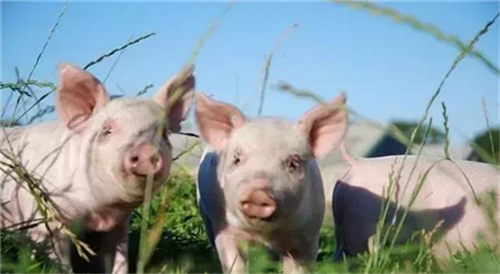When your pig vomits, what's the first thing you think of?
In the backstage of Wechat, some netizens left a message that the pig recently showed symptoms of vomiting, and in the process of connecting to the pig farm, the author found that pig vomiting is also a difficult problem for pig farmers. Today, the author takes an inventory of several diseases that may cause vomiting in pigs and the corresponding solutions. And invited senior veterinarian Luo Huaixian to give you some suggestions on the prevention and treatment of pig vomiting.
First of all, it is necessary to check the feed of pigs for mycotoxins, because the pig vomiting caused by mycotoxins is relatively frequent in winter. There is a vomiting toxin in mycotoxin, which is also one of the main culprits of vomiting in pigs. Pigs are very sensitive to vomiting toxins. Small doses of 50ug/kgb.w vomiting toxins can cause vomiting, and 2ppm-4ppm vomiting toxins can cause slow growth of pigs. After 8 weeks of feeding with 2.6ppm feed, obvious liver lesions occur. The main manifestations of pig poisoning were reduced feed intake, anti-feeding and vomiting. Pathological changes mainly occurred in stomach, intestine, skin and so on. Bleeding, necrosis and exfoliation of gastrointestinal mucosa can be seen. Blood biochemical examination showed that hemoglobin decreased and hematocrit decreased.

Vomiting in pigs caused by ingestion of feed containing vomiting toxin
Clinical symptoms of mycotoxin poisoning
First, suggestions
Q1 what are the possible causes of vomiting in pigs?
Luo Huaixian: if gastroenteritis occurs, vomiting and diarrhea will occur. In general, mycotoxins account for the majority, and sometimes there are gastric ulcers.
How should Q2 be prevented and controlled if it is gastroenteritis?
Luo Huaixian: first control the occurrence of new cases, and then control the secondary infection.
How to treat Q3 if it is caused by mycotoxin?
Luo Huaixian: it is recommended to repair gastric mucosa with gentian purple, detoxify with probiotics and oligosaccharides, and detoxify with sorbitol.
Second, several other diseases that cause vomiting in pigs
Transmissible gastroenteritis
Porcine transmissible gastroenteritis is a viral infectious disease, which is characterized by vomiting, severe diarrhea and other symptoms in piglets less than two weeks old. The mortality rate is very high, but the mortality rate of pigs over five weeks old is very low. There are great differences in clinical symptoms among pigs of different ages after being infected with transmissible gastroenteritis. for example, the clinical symptoms of bred pigs and fattening pigs infected with transmissible gastroenteritis are relatively mild and can be tolerated after several days of anorexia or diarrhea. Pigs that have been infected with transmissible gastroenteritis may not have any symptoms. The clinical symptoms of backup sows, basic sows and boars are diarrhea or anorexia. As there is still no effective treatment for the disease, we must pay attention to do a good job of vaccine immunization in advance.
Porcine epidemic diarrhea
The symptoms of porcine epidemic diarrhea are similar to transmissible gastroenteritis. It is also an acute intestinal infectious disease caused by viruses, which is common in fattening pigs and piglets. The disease is seasonal and often occurs from December of winter to February of the following year in China. Porcine epidemic diarrhea is similar to porcine transmissible gastroenteritis, often in the form of fulminant diarrhea. The main clinical symptoms of the disease are vomiting, diarrhea and dehydration. Feces are grayish yellow or gray, and faeces are as sparse as water. But the disease is slightly lighter than the latter, the speed of transmission is slightly slower, generally easy to vomit after accidentally eating feces or suckling, the severity of symptoms is also related to the age of pigs, the younger the age, the more serious the symptoms.
Porcine hemagglutinating encephalomyelitis
Porcine hemagglutinating encephalomyelitis can be divided into encephalomyelitis type and vomiting weight loss type. There is no regional restriction, and it can occur in pigs of different ages. Encephalomyelitis often occurs in suckling piglets, especially in piglets born less than a week ago. At the beginning of the disease, loss of appetite or even anorexia, followed by lethargy, vomiting, and constipation, very few will appear elevated body temperature. Severe patients have shuddering hair, blue limbs, sneezing, coughing, grinding teeth, gradually dyspnea, unstable pace, blindness, paralysis, and eventually coma to death. Vomiting emaciated symptoms are mild, initial body temperature increases, do not eat food, constipation, sharp weight loss, like a lot of water. Serious people cannot swallow, have difficulty drinking water, and die of dehydration a few days later. Encephalomyelitis type and emaciated type have extremely high morbidity and mortality, even if there is no death, they will stop growing.
Porcine pseudorabies
Porcine pseudorabies is caused by pigs infected with pseudorabies virus, which can occur all the year round, and the disease is widespread, which mainly depends on the age of pigs. The most serious disease is young pigs, which can easily cause a large number of deaths. After newborn piglets were infected with the virus, they mainly showed obvious neurological symptoms, elevated body temperature, persistent body fever, vomiting, lethargy, dysentery, and even foaming at the mouth, dyspnea, rapid onset and high mortality. Almost all of them died once they got sick. The symptoms of weaned piglets infected with pseudorabies virus are diarrhea and vomiting. Adult pigs generally have mild symptoms, characterized by mild fever, loss of appetite, cough and other symptoms, which are easy to recover.
Gastroenteritis
Gastroenteritis is a severe inflammation on the surface of the gastrointestinal tract, usually due to pigs eating moldy feed or eating something sharp by mistake, which can occur in pigs of all ages. At the initial stage, the diseased pigs only showed indigestion, loss of appetite and lack of energy. Severe vomiting, vomiting with blood or bile, accompanied by mild abdominal pain, bad breath, yellow tongue coating, cold limbs. If not treated in time, the symptoms worsen, diarrhea persists, and the stool is watery.
Gastric ulcer
There are three types of gastric ulcers, acute, subacute and chronic, which can occur in pigs of any age. Acute gastric ulcers have no clinical symptoms and mostly die of gastric mucosal bleeding; pigs with subacute gastric ulcers have obvious symptoms of anemia, weakness, anorexia, accelerated breathing, black stool, initial abdominal pain, molars, restlessness, and even vomiting, stool bleeding, dry defecation; chronic gastric ulcer pigs show loss of appetite or stop eating, feces show coal tar sample.
Parasitic disease
Porcine gastric nematode is a parasitic disease caused by Ascaris lumbricoides, Ascaris lumbricoides, Tetranychus and Taurus nematodes in the stomach of pigs. This kind of disease is more common in endemic pig vomiting, and its symptoms are not obvious, which increases the difficulty of treatment. Suffering from pigs, especially young pigs, there will be a large number of gastric nematode parasitism, resulting in gastric mucosal inflammation, increased thirst, loss of appetite, vomiting, weight loss, abdominal pain, anemia, chronic gastritis and so on.
Poisoning
Chemical poisoning can also cause vomiting symptoms, such as inorganic antimony poisoning, tin poisoning, arsenic poisoning, fluorosis, ethylene glycol poisoning and organophosphate poisoning. The vomiting symptoms caused by drug poisoning will not only harm the gastrointestinal tract, but also affect the central system. The vomiting caused by poisoning mainly includes piperazine poisoning and deworming drug poisoning, which will invade the gastrointestinal tract and blood. It leads to mental depression, pallor of the visual mucosa, erythema and emaciation of the skin of the extremities, affecting its normal growth and development. (source: pig Disease General Class)
- Prev

Analysis of the key work of postpartum sows and the prevention and treatment of abnormal conditions.
Analysis of the key work of postpartum sows and the prevention and treatment of abnormal conditions.
- Next

There are 11 causes of diarrhea in piglets of different ages. How can we prescribe the right medicine to the case?
There are 11 causes of diarrhea in piglets of different ages. How can we prescribe the right medicine to the case?
Related
- On the eggshell is a badge full of pride. British Poultry Egg Market and Consumer observation
- British study: 72% of Britons are willing to buy native eggs raised by insects
- Guidelines for friendly egg production revised the increase of space in chicken sheds can not be forced to change feathers and lay eggs.
- Risk of delay in customs clearance Australia suspends lobster exports to China
- Pig semen-the Vector of virus Transmission (4)
- Pig semen-the Vector of virus Transmission (3)
- Five common causes of difficult control of classical swine fever in clinic and their countermeasures
- Foot-and-mouth disease is the most effective way to prevent it!
- PED is the number one killer of piglets and has to be guarded against in autumn and winter.
- What is "yellow fat pig"? Have you ever heard the pig collector talk about "yellow fat pig"?

